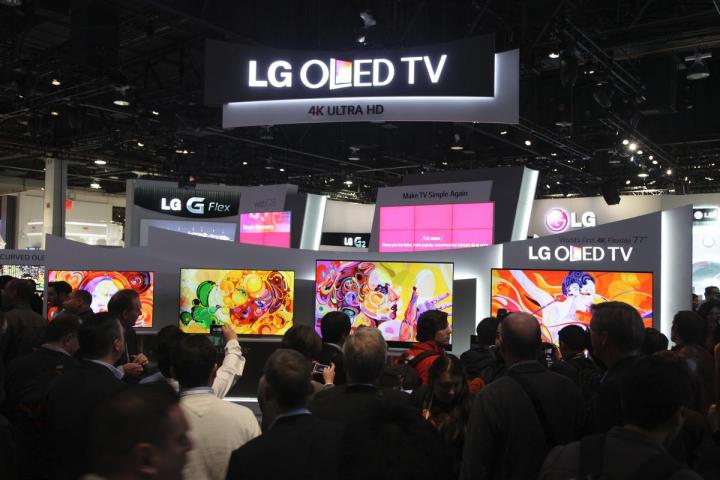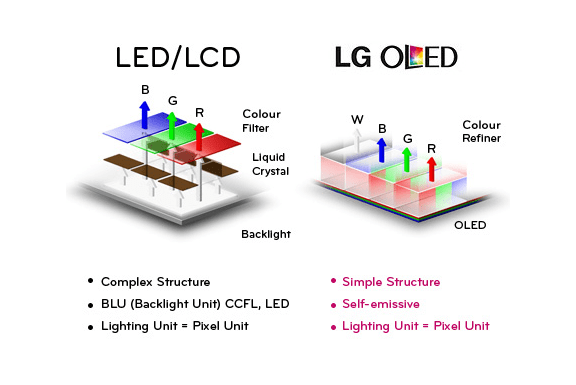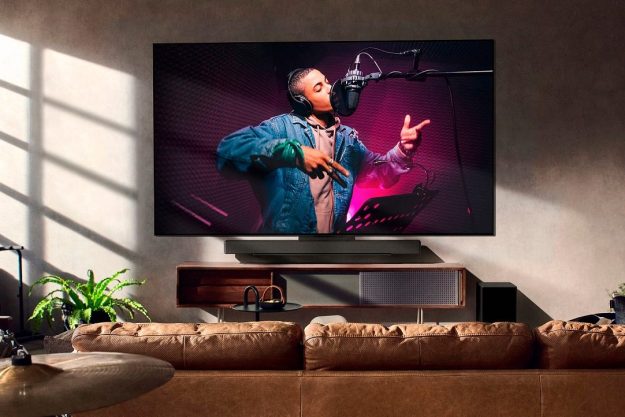
Even though OLED TVs deliver the most amazing display quality we’ve ever seen, things aren’t looking too great for the next-gen TV tech lately. In the last few months, Sony, Panasonic and Samsung have all indicated they are stepping back from OLED, leaving LG as the only player in town.
What’s going on? Is OLED doomed to the Hall of Lame, where prototypes of brilliant, promising ideas go to die? Will OLED TVs ever get cheap enough for people without private jets to afford them?
As we found out, there are reasons big-name TV makers are proceeding cautiously with OLED TV development and production, but they aren’t throwing in the towel entirely. And you might be surprised to learn that the motivations behind their decisions have less to do with the technology’s viability, and more to do with money.
Here’s why OLED TVs are here to stay, even in the face of recent headlines.
Dropping like flies
One need only look back as recently as December 2013 to see when all the hub-bub surrounding OLED TV production (or the lack of it) got started. It was then that Sony and Panasonic announced they were dissolving a partnership they had forged back in June 2012 to produce OLED panels together. The companies stated at the time that it was “technical challenges in improving panel durability and lowering production costs,” a sentiment we would hear repeated several times over in the coming months.
The crux of the issue here is that TV-sized OLED panels are a bear to produce.
Less than a week later, Sony made a formal announcement that it was shelving OLED so that it could better focus on developing its 4K TV lineup. Then, just three days ago, The Japan Times reported Panasonic had made a similar proclamation, adding that it couldn’t expect to raise profitability amid high production costs.
So you’re saying they’re hard to make?
Indeed, the crux of the issue here is that TV-sized OLED panels are a bear to produce. As Displaymate Technologies’ president Raymond Soneira explained to us, “The problem is that making large-screen 55-plus-inch OLED displays is still very technically challenging, with high development and manufacturing costs and low yields.”
When something is hard to make, it’s expensive to produce, which rarely translates into profit in the market. “Both LG and Samsung are still losing money on their $9,000 and $10,000 OLED TVs,” says Soneira. “Very few people can afford them. It’s going to take a while for the prices to fall. The same issues happened with plasmas. They started out very expensive at $10,000 or more, and it took at five plus years for the prices to become affordable enough to warrant spending new money to increase manufacturing capacity.”
In other words, manufacturers can’t sell more OLED TVs until they get cheaper, and they can’t get cheaper until they sell more. It’s a chicken-or-the-egg scenario that requires a company with deep pockets to keep pushing forward, even when the juice isn’t worth the squeeze today. No wonder so many manufacturers are stepping back from OLED.
Except LG.
Meet LG, the Lone Ranger of OLED in 2014
LG isn’t stepping back from producing OLED televisions this year. In fact, LG was the only major television manufacturer who came to CES 2014 with not just one new OLED television, but three new models, for a total of four OLED you can buy today. Not surprisingly, the company is vocally bullish on OLEDs while other companies shrink back.
“It takes a great deal of effort and expertise to develop viable large-screen OLED TVs, which is why we see some other manufacturers abandon it,” an LG spokesperson told Digital Trends. “LG’s OLED technology and manufacturing procedures have been improving since 2009, when we first created a 15-inch OLED display with WRGB technology. Today, we’re creating larger screen sizes at stronger yield rates and have advanced OLED TV production unlike any other manufacturer.”
So how is it that LG is in such a strong position with OLED while others appear so weak?
Dark days in Japan
Part of the reason Panasonic and Sony have pulled back from OLED is that both companies are struggling financially.
Panasonic has enough on its plate … throwing a bunch of money it doesn’t have at OLED would be a foolish move.
Panasonic is probably having déjà vu. Despite the fact that last year’s Panasonic plasmas were the best-performing non-OLED televisions ever produced, it has been losing money on them for years. Ultimately, Panasonic had to halt its plasma TV production, which, in a twist of irony, has videophiles looking to OLED to take the reins. Panasonic has enough on its plate keeping competitive in the LCD TV market, though, so throwing a bunch of money it doesn’t have at OLED would be a foolish move.
Sunny days in South Korea
Meanwhile, South Korean TV titans and arch rivals, Samsung and LG, are doing pretty well. Samsung remains the number-one TV manufacturer in the world (since 2006), with LG following very closely behind. With very diverse product profiles, many of which reach well outside of consumer electronics and into other categories such as major appliances, it’s safe to say both companies have a few bucks stashed away that they could spend on OLED development. But while LG is going gangbusters with new OLED TVs this year (and already announcing what it will be showing off next year), Samsung has remained relatively quiet since introducing the KN55S9C, its one and only consumer OLED TV set in 2013.
That doesn’t mean that Samsung is out of the running, though. The company may have decided that it isn’t going to dump a bunch of money on an OLED factory until it has come up with an OLED panel production approach that is significantly less costly. Currently, Samsung and LG use different approaches to OLED panel engineering. As Soneira explains, “Samsung uses an expensive Low Temperature Poly Silicon LTPS backplane for their R,G,B OLED TVs, while LG uses an IGZO backplane with all white OLEDs with R,G,B,W color filters, so their costs are lower.”
All that tech-speak means is that there is more than one way to skin an OLED cat, and Samsung’s is more involved and costly. Having spoken to Samsung extensively about its OLED methods, we know that the company very much prefers its approach, and is not willing to sacrifice what it feels is superior quality for the sake of cranking out a product that not a lot of people are in a position to purchase anyway. Also consider that Samsung is putting its full muscle behind the marketing and production of its curved Ultra HD televisions. If you haven’t seen the ads yet, don’t worry … you will soon enough.

As for an official stance, Samsung denies retreating from OLED entirely. “We will continue our investments and R&D in OLED TVs as according to market demands,” a spokesperson told Digital Trends.
Meanwhile, LG isn’t just making its own OLED panels, it’s producing them for less popular Chinese TV manufacturers such as TCL and Haier. That being the case, it would seem LG is comfortable with its production process. The question is, how hard will LG push for larger, faster production facilities? It may not matter, because LG can’t drive the price of OLED panels down on its own. That takes competition.
LG may end up getting that competition. Samsung won’t sit quietly for long, and there are rumors stirring around that Sony and Panasonic may jointly work with a company called Japan Display to help get OLED running again.
Be patient, OLED TVs will come … in time
Those who’ve never seen an OLED TV in action may be understandably puzzled as to why anyone would bother to follow its development so closely or speculate about its future. After all, we’ve already got Ultra HD 4K televisions threatening to make newly-acquired 1080p HD televisions obsolete. And then there’s the curve craze manufacturers insist on forcing upon us. Isn’t that enough?
Those of us who are fortunate enough to have spent some time gazing into an OLED’s nearly perfect picture, though, understand that OLED TVs amount to more than just a design fad or an incremental step up from plasma; they are a quantum leap forward in terms of form and function. You don’t have to be a videophile or even a tech enthusiast to see just how stunning an OLED TV is. When you see one, you want one. And one day you’ll be able to buy one. One day …
OLED TVs are more than just a design fad or an incremental step up, they are a quantum leap forward.
For now, consumers will have several OLED television options to look at this year, but the only options worth looking at will come from LG and Samsung. This will be the first year that OLED TVs have made a slide downward in price, though we don’t expect any jaw-dropping discounts. Samsung still offers its 55-inch KN55S9C for about $9,000, but that could go down later this year. LG will have an array of OLED TVs available, ranging from a “budget-priced” 55-inch model all the way up to a 77-inch curved, UltraHD model, though pricing has yet to be announced.
Will you buy one just to be on the bleeding edge? Or are you content to wait until OLED TVs cost less than a new(ish) car? Let us know in the comment section below.
Editors' Recommendations
- This LG TV has a bendable OLED screen (really) and it’s $999 off
- You Asked: Sony surround, FlexConnect vs. Sony HT-A9, LG G4 vs. Samsung S95D
- This massive 77-inch LG OLED TV is $400 off at Best Buy
- Samsung unveils pricing and preorder details for its 2024 OLED TVs
- OLED vs. LED: Which kind of TV display is better?






